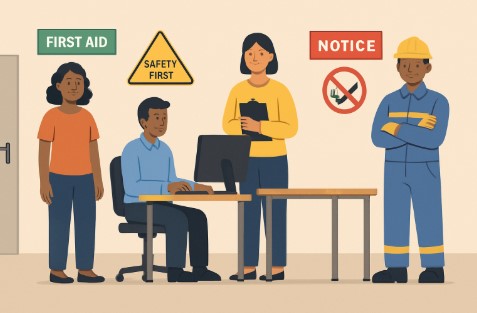Creating a safer workplace isn’t just about compliance—it’s about protecting the well-being of employees and supporting a more productive environment. Injury risks exist in nearly every industry, whether on a construction site or in an office setting. Taking proactive steps to identify hazards, promote safety training, and improve processes can significantly reduce the chances of accidents.
Minimizing workplace injuries goes well beyond simply adhering to regulatory requirements—nurturing a robust, energetic work environment where employees can be at their best. When team members feel secure and appreciated, they are more likely to be productive, engaged, and loyal. Proactively addressing safety shields employees from harm and delivers tangible benefits to the business, including reduced operational downtime, fewer workers’ compensation claims, and improved organizational morale. To ensure all bases are covered, organizations should consider leveraging comprehensive workers’ compensation solutions at https://www.adp.com/what-we-offer/benefits/business-insurance/workers-compensation.aspx as a crucial part of an advanced risk management approach. Leaders can redefine a company’s work culture and long-term success by deliberately making safety a central value, rather than a simple checklist item.
Develop Comprehensive Safety Programs
A safety program is crucial for injury prevention in any industry, facility, or team. It should be tailored to address employees’ hazards, such as machinery, hazardous materials, ergonomic challenges, or workplace violence. Safety programs should be dynamic, evolving alongside technological advancements and updated standards from OSHA and industry-specific governing bodies. A best-in-class safety program requires ongoing input and ownership from every company level, securing leadership commitment and front-line engagement. Key elements of effective safety programs include customizable checklists, guidelines, and protocols targeting industry and site-specific risks, consistent documentation of workplace incidents, and rigorous analysis to identify patterns and root causes. Alignment with relevant regulations, such as OSHA, state, and local labor laws, and best industry practices ensures legal compliance and demonstrates an ongoing investment in employee welfare.
Conduct Regular Risk Assessments
Risk assessments are not one-time checklists—they are continuous, systematic efforts to seek out current and potential hazards in every workplace corner. Conducted thoroughly, these assessments will uncover obvious physical dangers and subtler ergonomic and psychosocial risks, enabling employers to address issues before they cause harm. Involving seasoned safety professionals and front-line employees is essential, as workers closest to daily processes often have the best insight into unnoticed dangers. Once risks are identified, organizations should evaluate the effectiveness of existing controls, and, where gaps are found, set about introducing or upgrading risk mitigation measures. This ongoing cycle of investigation, improvement, and communication instills a habit of vigilance, encourages employee involvement, and ensures the workplace remains adaptable and responsive to emerging threats.

Steps for a Thorough Risk Assessment
- Identify hazards: Physically inspect and observe every workspace and activity, noting chemical, physical, and ergonomic hazards and even psychosocial stressors like workload and workplace culture that could cause harm.
- Analyze potential harm: Assess the likelihood and severity of injury, illness, or damage associated with each hazard, and clearly identify which groups or individuals may be most at risk.
- Evaluate current controls: Critically examine whether existing safety devices, protocols, personal protective equipment (PPE), and training initiatives effectively control risks and identify any logistical or behavioral gaps.
- Implement improvements: Based on findings, update or introduce new safety measures. Communicate all adjustments clearly to every relevant employee and conduct follow-up evaluations to ensure these controls are functioning as intended.
Provide Ongoing Employee Training
A safe workplace relies on a well-trained workforce understanding risks, hazards, equipment operation, material handling, and emergency response. Training should be tailored to the role, interactive, and adaptable to evolving workplace realities. Refresher courses are essential, especially as procedures, technology, or job requirements change. Training should not only be for full-time staff but also for temporary workers, seasonal hires, and contractors. Essential training topics include understanding company-wide safety policies, emergency response plans, and evacuation procedures. It should also cover safe machinery operation, PPE use, hazard identification, incident reporting, and real-time risk mitigation strategies. First-aid basics like CPR and bleeding control are also essential, along with situational awareness to boost quick thinking during emergencies.
Implement Ergonomic Workspaces
Ergonomics is crucial for long-term employee well-being, as poorly designed workspaces can lead to repetitive motion injuries, musculoskeletal disorders, and chronic pain, reducing productivity and increasing absenteeism. Organizations should incorporate ergonomics into their safety review process, involving employees and providing training in correct postures and movements. Effective ergonomic strategies include providing adjustable furniture, promoting regular microbreaks, stretches, and movement routines, deploying automated lifting equipment, and optimizing workspace design for natural, efficient movement. Involving employees in the process, encouraging early discomfort reporting, and training in correct postures and movements can lead to immediate and lasting benefits for individual comfort and organizational efficiency. This approach can be applied to various settings, including offices, warehouses, manufacturing plants, and remote workspaces.
Foster a Culture of Safety
A safe workplace is essential for organizational success. This is achieved through leadership setting a clear example and empowering employees to raise concerns, suggest improvements, and report hazards without fear of negative consequences. Open communication channels, regularly recognizing safe practices, and celebrating achievements foster accountability and team spirit. Trust grows when everyone is involved, leading to candid discussions and innovative ideas for injury prevention. Over time, this culture becomes self-sustaining, driving ongoing improvements and reducing risks at all levels. Building blocks for a safe workplace culture include consistent safety meetings, feedback sessions, open forums, active safety committees, and strategic incentive programs that recognize and publicly celebrate individuals and teams demonstrating outstanding commitment to safety protocols and initiatives.
Integrate Technology for Safety Monitoring
Technology advancements are revolutionizing workplace safety by enabling real-time monitoring, analysis, and risk response. Smart wearables can detect hazardous movements, fatigue, or environmental changes, alerting employees and supervisors instantly. Predictive analytics and cloud-based software systems centralize safety data, ensuring compliance and forecasting future risks more accurately. Workers’ compensation partners offer integrated tools for automating incident tracking, claims management, and corrective action workflows. Training has also been revolutionized by technology, with virtual and augmented reality simulations allowing employees to gain hands-on experience with dangerous tasks in a controlled environment. By prioritizing technology integration, organizations can remain agile, extend their safety reach, and continually enhance their safety posture. Innovative safety technologies include wearable sensors, data-driven software platforms, and immersive training solutions. By embracing these steps, businesses can reduce workplace injury risks and foster environments where employees feel safe and respected. This leads to higher morale, increased retention, and a reputation for valuing the organization’s most important asset: its people.



